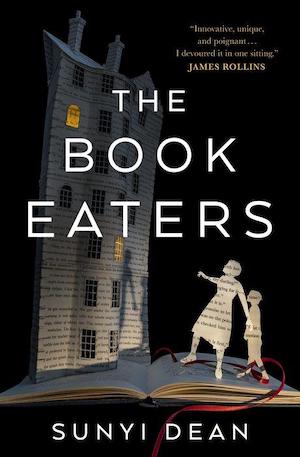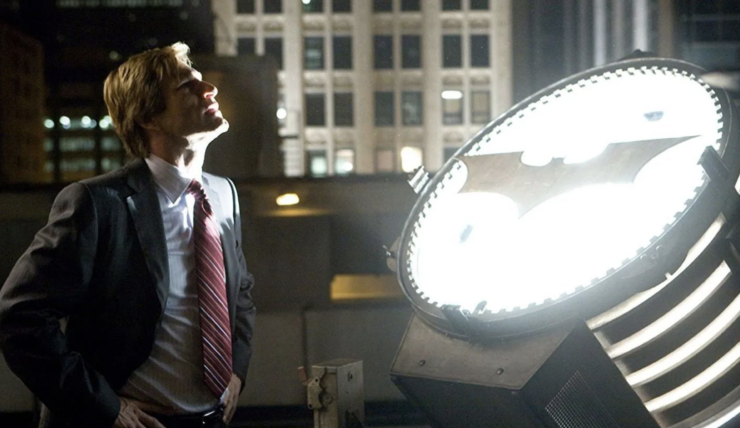I had a minor epiphany during my most recent viewing of Christopher Nolan’s The Dark Knight (2008): Despite the posters prominently featuring Heath Ledger’s Joker, despite even the film’s own name, The Dark Knight is really about Two-Face.
“No duh,” you say. “You got Two-Face’s origin story in it, of course it’s about him.” But that isn’t what I mean.
What I mean is that, while a good chunk of The Dark Knight does focus on the crusading, politically ambitious D.A. Harvey Dent (Aaron Eckhart), and how having half his face gruesomely disfigured in an explosion twists him into a homicidal maniac, the super-villain’s influence suffuses the film beyond just his own story. As has been established in the comics, animated series, and his previous, campier incarnation in Batman Forever (and the less we dwell on that, the better), Two-Face is all about that twoness. In previous versions, he’s hired twins as lackeys, picked his victims based on some connection with the number two, and—in the most prominent trope that gets ported over to this film—leaves the fate of said victims up to binary chance, flipping a two-headed coin to decide whether they live or die.
In The Dark Knight, though, it goes deeper than that—duality is all over the place. There are the more obvious contrasts between crime and justice; law enforcement vs. vigilantism; and of course the psychological tension between billionaire playboy Bruce Wayne (Christian Bale) and his masked alter-ego, the Batman. But it doesn’t stop there. The film goes deeper with the binaries, trapping A.D.A. Rachel Dawes (Maggie Gyllenhaal) in a conflict between romantic rivals Dent and Wayne; saddling engineering mastermind Lucius Fox (Morgan Freeman) with a moral dilemma between staving off a reign of terror or violating the privacy of the citizens of Gotham; and burdening soon-to-be Commissioner Gordon (Gary Oldman) with a choice between his family and seeing through a plan to capture the Joker. And ultimately, it works its way into two of The Dark Knight’s major setpieces, one in which Batman races to rescue both Dent and Dawes from death traps set at opposite ends of the city; another where the passengers of two bomb-laden ferries—one a group of criminals, the other ordinary citizens—are challenged to save their own ship by blowing up the other.
Once again, you’re saying, “But wait a second—Two-Face wasn’t involved in those last two things. Those were actually the doings of the Joker.” Yup, you’re right, obviously. And that’s where it gets interesting.
I haven’t looked into the genesis of the Dark Knight script, co-written by Nolan and his brother Jonathan, with story by David S. Goyer. I can easily imagine that in some earlier form, those sequences, with some obvious alterations of narrative placement and characters, were indeed the doings of Two-Face—they have his M.O. written all over them. Problem is: That Two-Face isn’t the one the Nolans have given us. In The Dark Knight, Dent’s transformation arrives late in the run, with minimal establishment of the split personality that’s supposed to drive the once-dedicated D.A.’s turn to crime (to be frank, Batman: The Animated Series did a better job setting up the character). Instead of being the perpetrator of the grandiose crimes for which Batman villains are well known, this Harvey is focused on a more grounded vengeance spree: seeking out the people directly responsible for ruining his life, and deciding their fates with a flip of the coin. With one bad guy diverted from his traditional arc of becoming a classic, hyperbolic criminal—one suited to taking on the Bat—it fell to another to orchestrate terror on a grander scale. Enter the Joker.
Yes, we’re finally getting around to him. If you were wondering how I could possibly ignore the film’s other Big Bad for this long, that’s only natural—the role that deservedly won Ledger his posthumous Oscar is the one thing in The Dark Knight that’s impossible to forget. And I’m not kidding—I hadn’t seen the film for several years, and I’d completely forgotten about Jim Gordon’s fake-death, and the weaselly Wayne Enterprises employee who tries to capitalize on his knowledge of Batman’s secret identity, and even that one of my favorite actors—Nestor Carbonell—plays the Mayor. But the Clown Prince of Crime? Ah, I remember every repellent lip-lick, every psychotic utterance, and every atrocity the madman commits.
That may be because—similar to what they did with Two-Face—the Nolans have once again retooled the criminal to suit their own vision. Gone is the comic-book jokester with the image-appropriate gimmicks—the lethal laughing gas and the death traps triggered by giant, boing-boing springs. In that goofball’s place is a deadly and dangerous criminal mastermind, with the only connections to his previous incarnations being a clouded back story—we get two versions here, neither of which involve being dropped into a vat of toxic chemicals, as has been traditional—and the sense that the man is laughing at jokes that no-one else gets. The Nolans have a clear purpose for their revision, one spotlighted when, early in the film, the Joker caps off an offer of his services to an assemblage of Gotham’s crime bosses by proclaiming, “My card!” and slapping down a regular Joker from a deck of playing cards. On the one hand, it reads as a typical Joker gag, and a funny one at that—I chuckled. On the other, it’s also a pointed indication of what role the villain will play in the film overall: In a standard deck, the Joker is the wild card, capable of anything. As indeed is this flesh-and-blood version.
And that’s the secret sauce to The Dark Knight’s power. Turns out that of all the dualities The Dark Knight evokes, there’s only one that truly matters: The conflict between order and chaos. It’s the factor that makes the film so compelling, and the Joker so indelibly terrifying. It’s not surprising that Nolan would leap at the opportunity to throw this bit of randomness into what would otherwise be a more conventional superhero dust-up…after all, without the Joker, The Dark Knight just has its superhero and its weird villain (backed up by a more banal mob boss played by Eric Roberts), and big deal. But throughout his trilogy of films, Nolan pushes to deconstruct the whole, calcified notion of what a Batman movie is. In Batman Begins he blew up the German Expressionist/High Camp Gotham of the Burton and Schumacher films to make way for a more realistic, filmed-in-Chicago setting; in The Dark Knight Rises, he introduced a Catwoman who’s never referred to as such. And here he takes possibly the most formulaic of the Caped Crusader’s adversaries and reimagines him as an X-factor, a loose cannon who flies in the face of formula. “Introduce a little anarchy,” the Joker advises a disfigured Dent. “Upset the established order, and everything becomes chaos.” And, just coincidentally, more entertaining.
But also, curiously, more gratifying. There’s a reason why so many mainstream action films are dismissed—and occasionally praised—as roller coaster rides. For whatever dips, turns, and loop-the-loops a roller coaster may boast, it’s still a vehicle travelling over a rigidly fixed track. The course can never change, and your destination is always assured. These are manufactured thrills, and frequently hollow because of that.
Buy the Book


The Book Eaters
But here’s a little thing about roller coasters: The best of their designers will build flaws into their layouts, little, subconsciously perceived bumps and dips that suggest the track isn’t as exquisitely engineered as it may actually be—things might get dangerous, chaos may still reign. And so Nolan introduces the Joker, and by dint of his randomness—so random that he actually burns a huge pile of money, his commission for rescuing Gotham’s crime lords from the slammer—the madman commandeers the typical cinematic thrill ride, steers it off its track, and onto a path whose destination is unknown, maybe even to the Joker himself.
And the film is better off for it. Even though Ledger’s Joker is on-screen for all of thirty-three minutes, he is the thing that makes The Dark Knight not only one of the best Batman movies, but one of the best superhero movies overall. And what breaks the film away from the pack is its willingness to embrace that X-factor, to throw a monkey wrench into commercial cinema’s best-laid plans.
Another thing the Joker tells Dent is, “Nobody panics when things go according to plan. Even if the plan is horrifying.” Plans—formulas—are what make most action films, and tangentially most horror films, such bores. Introduce chaos, the unknown, the unexpected into the formula, and eyes can be opened, imaginations can be stirred.
Chaos is rarely considered a beneficial force, but as the Joker says, “It’s fair.” It creates the challenge that allows characters—both good and evil—to rise to their greatest selves. And by extension, chaos is the thing that tests us on a day-to-day basis. A more benign figure, John Lennon, phrased it as, “Life is what happens to you while you’re busy making other plans.” Chaos, whether represented by a psychotic clown, or a flat tire in the middle of your exquisitely planned road trip, is a part of the natural order. It doesn’t care if you acknowledge its presence, but we’re better off when we do.
* * *
Chris Nolan’s Dark Knight trilogy is one of the most complex and engaging batch of superhero movies around. I’m perfectly down with anything that elevates a film franchise into something more than a cash machine for the mammoth media corps (even if I think The Dark Knight Rises may have pushed the whole iconoclasm thing a bit too far). But what do you think? Is Nolan’s take on the Caped Crusader a stimulating reevaluation of the superhero film or just an over-intellectualized drag? However you feel, we want to hear from you. Scroll down to the comments box below and—cordially, joyfully—give us your thoughts.
Dan Persons has been knocking about the genre media beat for, oh, a good handful of years, now. He’s presently house critic for the radio show Hour of the Wolf on WBAI 99.5FM in New York, and previously was editor of Cinefantastique and Animefantastique, as well as producer of news updates for The Monster Channel. He is also founder of Anime Philadelphia, a program to encourage theatrical screenings of Japanese animation. And you should taste his One Alarm Chili! Wow!










